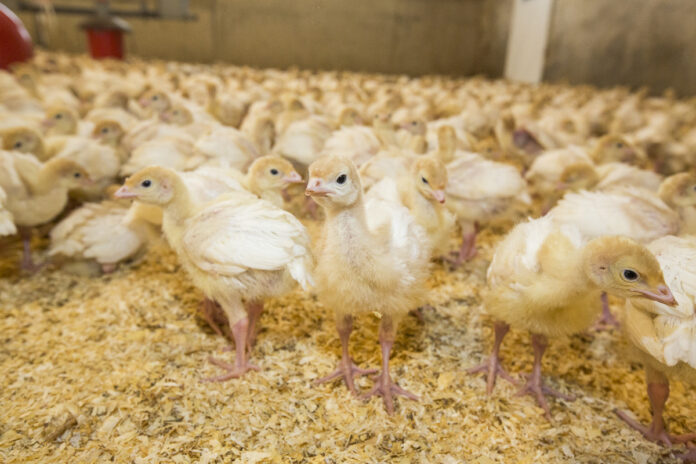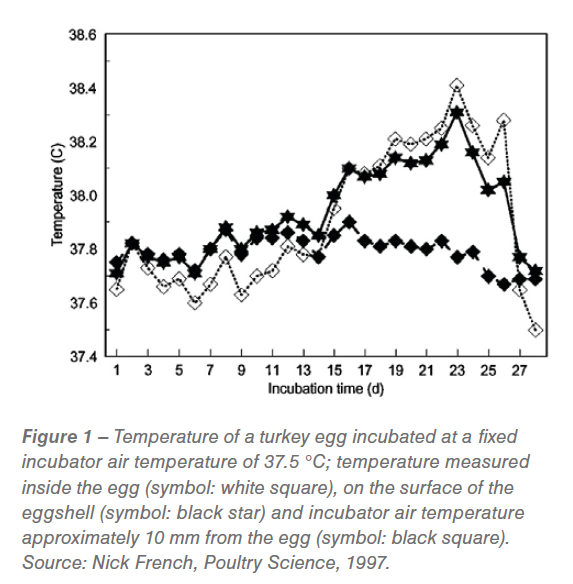
Incubating turkey eggs is often considered to be more challenging than incubating broiler eggs, yet, in essence, the basic principle of success is the same in both turkey and broiler hatcheries. Continuously monitoring the incubation process is crucial to understand what the embryo inside the egg is experiencing and to ensure incubation success. This article highlights four key points a turkey hatchery should closely monitor to reach excellent hatchability and poult quality.
Dr Nick French, Independent Poultry Incubation Expert
Key points for turkey egg incubation
There are some differences between turkey and broiler eggs. First, turkey eggs generally take 28 days to incubate compared to the 21 days of broiler incubation. Second, turkey eggs are larger than broiler eggs: While the average egg weight of a broiler egg through production increases from 50 to 70 grams, the average turkey egg weight increases from 79 to 97 grams. Third, most – but not all – broiler breeder flocks worldwide are naturally mated whereas the vast majority of turkey breeder flocks are artificially inseminated. Consequently, fertility tends to be higher in turkey eggs, particularly towards the end of production.
Even though there are species-specific considerations to manage, the starting point always is what the embryo experiences during incubation. A turkey hatchery should closely monitor four key points to understand what the embryo inside the egg is experiencing and to ensure incubation success. The following sections each focus on one of these key points.
Incubation temperature
Of all the parameters that determine incubation success, temperature is the most important one; more specifically, the temperature experienced by the embryo inside the egg. Below graph shows the temperature inside a turkey egg, the temperature on the surface of the eggshell and the incubator air temperature approximately 10 mm from the egg (= micro-environmental air) when turkey eggs are incubated at a fixed machine temperature of 37.5 °C:
•During the first 11 days of incubation, the internal egg temperature is slightly lower than the micro-environmental air temperature because of evaporative cooling. The embryo is still small, so it produces little metabolic heat.
•However, as the embryo starts to grow larger and larger, it produces more and more metabolic heat. Around mid-incubation, the metabolic heat level exceeds the level of heat loss through evaporative cooling. By the end of incubation, the internal egg temperature exceeds the micro-environmental air temperature by approximately 0.5 °C.
•The difference between the internal egg temperature and the macro-environmental air temperature (= temperature measured near the machine sensor and indicated on the incubator controller) is assumed to be even bigger than 0.5 °C, depending on the machine layout and the airspeed over the egg. To avoid overheating of the eggs and reduced incubation results, it is therefore important to continuously monitor and control the internal egg temperature, especially during later phases of incubation, because the temperature increases as the embryo grows.
The internal egg temperature is of paramount importance… But how to monitor this parameter? An important finding illustrated by the graph is that the eggshell temperature closely follows the internal temperature. Hence, the eggshell temperature is routinely used in commercial incubation to pragmatically estimate the internal temperature. For both turkey and broiler eggs, the consensus is that the optimum eggshell temperature during incubation is around 37.8 °C (100 °F). When the eggshell temperature deviates from the optimum, incubation performance is at risk.

There are several ways to monitor the eggshell temperature. For spot checks you can use a standard ear thermometer used to measure the human body temperature. However, performing the temperature measurements will ultimately interrupt and disturb the process. For continuous monitoring without interrupting the process, you can use data loggers with surface temperature probes. With this method, there are also some things to consider. The data loggers will help to record the temperature and visualise the data, but they will not actively steer the temperature control in the machine.
As turkey eggs are larger than broiler eggs, the larger turkey embryo will also produce more metabolic heat, typically around 15% more at the end of incubation than a broiler embryo. Therefore, it is crucial that turkey incubators have proportionally either increased cooling capacity or reduced egg capacity to compensate for the increased metabolic heat production. Even more importantly, turkey eggs require more volume of air passing over each egg, both between the eggs on the tray and between the trays themselves. This is important to allow more air volume to pass over the eggs and remove the surplus heat. Increasing the egg density on the trays or reducing the spacing between the trays can have adverse effects on performance, even if the cooling capacity of the machine has been increased, as this will reduce the heat exchange efficiency between egg and air.
Incubator humidity
Eggs lose water during incubation. This water loss is needed to generate a sufficient air cell space for the embryo to inflate its lungs after internal pipping. The humidity level of the air surrounding the eggs determines the rate at which they lose water and, as a result, lose weight. The higher the humidity, the lower the rate of water loss (weight loss). The air cell can end up being too small when eggs do not lose enough water. So, the lungs of the embryo cannot fully inflate, and the poult will not be able to obtain enough oxygen for the hatching process, leading to an increased number of embryos pipping, but not hatching. On the other hand, too much water loss can cause embryo dehydration. An increased number of early dead germs can be an indicator for this.
Studies have shown that the best hatch results are obtained when a turkey egg loses between 10 to 12% of the fresh egg weight by day 25 of incubation. This can be monitored by weighing the trays at set and at transfer and calculating the percentage of water loss following the breeder’s guidelines.
Ventilation
Ventilation is crucial in the control of the incubation temperature and incubator humidity. Incubators need to be properly ventilated to supply the embryo with oxygen (O2) and to allow the produced carbon dioxide (CO2) and evaporated water to escape. Some incubator types also depend on ventilation to cool the eggs. The level of ventilation should be sufficient to meet the embryo’s requirement to breathe. However, it is also important not to over-ventilate. In general, the fresh air brought into the machine is cooler and dryer compared to the air inside the machine. This means the more air is brought in, the more difficult it becomes to maintain the required humidity and keep a uniform temperature within the machine without local hot and cold spots.
If ventilation is required to supply O2 and remove CO2 only, then measuring CO2 levels within the machine can be used to properly control the ventilation levels.
Incubation time
The correct incubation time is essential to give turkey poults the best possible start in post-hatch life. A common issue is that poults are held in the hatcher for too long in an attempt to make each egg hatch. This can lead to high mortality and uneven early growth on the farms. Knowing what to pay attention to can make the difference.
The behaviour of turkey poults at take-off is a good indicator to quickly identify issues. In case the poults were held in the hatcher for too long, you can expect to see very noisy and active birds that have little yolk reserve left. Their legs are very thin due to dehydration. In addition, the hatcher baskets are stained with dark green meconium. On the other hand, if incubation time was correct, you can expect to see calm and quiet poults that stand up. Around 5% of the poults might have a wet nape (back of the neck), but no poults are entirely wet. The debris in the hatcher baskets is clean with only a few meconium stains.
In summary
The basic principle of success is the same in both turkey and broiler hatcheries. Continuously monitoring the incubation process is crucial to understand what the embryo inside the egg is experiencing and to ensure incubation success. We need to use the egg to tell us what to do. This is an essential part of achieving the best performance in our hatcheries.
Source: Petersime

















